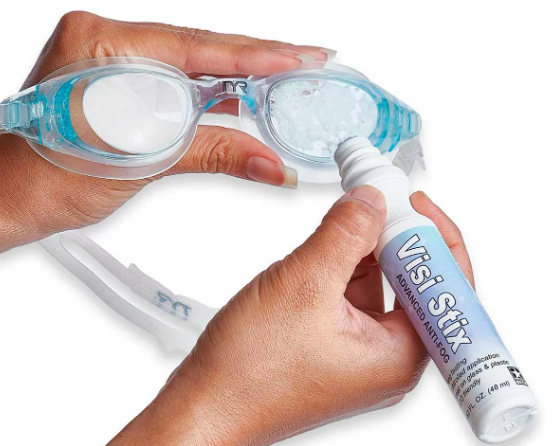Why do glasses fog up? This primarily applies to swimming goggles, but regular ones for vision also cause similar troubles to their owners. Read on to learn how to get rid of fogged lenses.
How to use for regular glasses
Only if you apply the selected product in accordance with the instructions, it will act for a long time and correctly. Do not use expired antifog, it can even be harmful to health.
Instructions:
- First, the lenses need to be thoroughly rinsed to remove dust;
- degrease (it is better not to use alcohol-containing preparations - they can ruin your glasses);
- dry without using any wipes;
- Following the dosage prescribed in the instructions, apply the product, spread over the surface and leave to dry in a dark place away from heating devices.
You can carefully cover your glasses with a lint-free cloth - this way you protect them from dust.
Important! You cannot dry glass outside after antifog treatment. They may become subject to dust and debris.And the sun's rays have a detrimental effect on the formed film.
How to use antifog for swimming goggles?
Swimmers have to use this remedy much more often. This is due to both the intensity of training and environmental influences. Chlorine pool water washes off the coating faster.
Gels and solutions will last longer but require more processing time. Wipes or spray Only enough for one workout, but you can use them right before the start of the swim.
Instructions. Degrease, dry, wipe with antifog - and into the pool!
The product is convenient not only for swimmers and bespectacled people. He was appreciated and motorcycle owners, And photographers. The first ones process the inner surface of the helmet, the second ones process the photo-optics. Antifog is irreplaceable and when shooting underwater.

What kind of product is antifog?
Direct translation from English is “anti-fog.” In fact, you can't say more precisely. There are products that can remove the “fog effect” from the eyes, or rather, from the lenses. Old and proven methods - Lubricating glasses with toothpaste, baby shampoo or concentrated soap solution.
True, the effect of such products is quite doubtful even for glasses worn every day, and practically unsuitable for skiers or swimmers - and it’s not enough for one workout. But now a modern remedy has appeared - antifog. Expensive glasses are treated with it at the production stage, and if your glasses don’t have it, you can take it to an optician (an expensive pleasure) or process it yourself.

Liquid composition
Quite a lot of companies produce this miracle product. But the main components often intersect, only the accompanying ones change. Almost all antifogs include:
- water (more than 80% of it in the product);
- decyl polyglucose (for foam);
- polyurethane (allows the protective film formed on the glass surface to remain flexible);
- polyvinylpyrrolidone (for stabilization);
- methylpyrrolidone (as solvent);
- triethylamine (as a hardener).
The principle of its operation
This cocktail, when applied to glasses and then dried, forms a film that allows the glasses not to sweat for quite a long time. Thanks to its complex composition, the product is evenly distributed over the surface. In addition to the main function, such The film also protects the glass from exposure to adverse environments.. For example, dust does not accumulate on glasses treated with antifog; water drains from the glasses faster, leaving no drops or streaks.
There is no need to fear that such a “hard-to-read” composition will lead to allergies. Manufacturers use only substances that do not cause any reactions. But this is possible if you have an individual intolerance to the substances included in the composition.
Read the information on the packaging carefully! Antifog can be used to treat goggles for swimming, snowboarding, paintball, regular lenses for everyday wear, and sunglasses.
Important! Do not use car glass cleaner on your glasses. They may contain substances that can harm humans!

Types of antifog products
This miracle product is available in the form of a solution, spray or wipes. The latter are easy to use - wipe the lenses of your glasses and let them dry (this will take less than a minute). In addition, antifog will always be at hand. Usually there are from 6 to 10 napkins in a package, but they often sell one piece for testing.
The good thing about the spray is that dries instantly. It can be used immediately before training.You just need to carefully read the instructions before use and do not forget that after processing, for example, swimming goggles, they must be rinsed in water before putting them on.
The gel creates a more durable coating, but also takes longer to dry.
Important! Be careful - many solutions are made specifically for underwater masks. They have additional properties - they repel dirt and protect against dust, but not all of them can be used for regular glasses.

How often is antifog applied?
It all depends on the goals and what type of product you use. The most short-lived coating is created by napkins. A spray, gel or solution lasts for a longer period.
Most often you have to use antifog for swimming goggles. For professional training, the treatment may only last a few hours. For rarer, “amateur” use, the protective film will last for a couple of sessions. Regular eyeglasses may need to be re-treated only after a month or two.
Important! Correct handling will prolong the effect of antifog significantly. You just shouldn’t wash your lenses under a very strong stream of water, rub your fingers on the glass, or leave your glasses near heating devices.



 0
0





